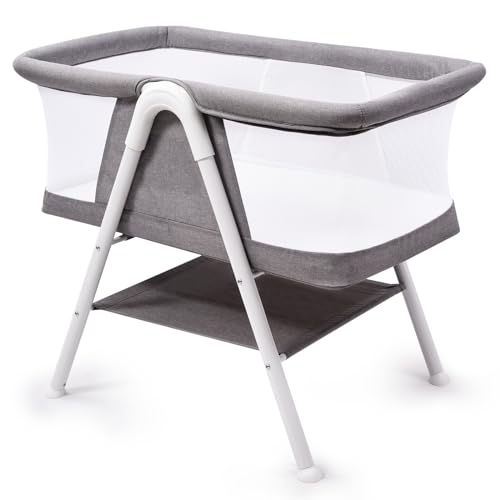8 Tips To Enhance Your Baby Cots Game

The Ultimate Guide to Baby Cots: Choosing the Best for Your Little One
When it comes to getting ready for a new arrival, selecting the ideal baby cot is among the most important decisions expectant moms and dads will make. Suggested Resource site serves not just as a place for the baby to sleep but likewise as a safe sanctuary where they can grow, check out, and establish. This guide explores the different types of baby cots, crucial considerations for choice, security requirements, and more, helping parents navigate the myriad choices offered.
Kinds Of Baby Cots
Picking a baby cot involves understanding the various types readily available on the marketplace. Each has its distinct features and advantages that accommodate various needs and way of lives:
| Type of Cot | Description |
|---|---|
| Standard Cot | A standard design with repaired sides, designed for long-term use up until the child transitions to a bed. |
| Portable Cot | Light-weight and collapsible, perfect for travel or smaller sized living spaces. |
| Crib | Typically smaller sized than a basic cot, designed specifically for babies. |
| Convertible Cot | A versatile choice that can change into a toddler bed, daybed, or perhaps a full-size bed as the child grows. |
| Co-Sleeper | A bedside crib that connects to the moms and dads' bed, enabling simple nighttime access while keeping the baby safe. |
| Moses Basket | A lightweight, portable basket ideal for newborns, enabling easy movement from space to room. |
Key Considerations When Choosing a Baby Cot
Selecting the ideal cot involves a number of factors to consider to guarantee it meets safety standards while also being useful for everyday use. Here are some vital elements to bear in mind:
- Safety Standards: Ensure that the cot meets the security guidelines set by your country's requirements.
- Material: Look for non-toxic materials that won't seep damaging chemicals into the baby's environment.
- Adjustable Height: Consider cots with adjustable bed mattress heights, that make it simpler to raise the baby in and out as they grow.
- Size: Make sure the cot fits conveniently in the designated area, enabling room for safe motion around it.
- Longevity: Opt for convertible cots that can shift as your child grows, saving both space and money.
- Aesthetic Appeal: Select a design and color that complements your nursery style.
- Alleviate of Assembly: Review how intricate the assembly process is; some cots can be cumbersome to assemble.
Safety Tips for Baby Cots
Guaranteeing the baby's security while they sleep is critical. Here are important safety suggestions for baby cots:
- Use a Firm Mattress: A company bed mattress that fits snugly in the cot reduces the risk of suffocation.
- Bed linen: Keep soft bed linen, pillows, and toys out of the cot to lower the threat of Sudden Infant Death Syndrome (SIDS).
- Look for Gaps: Ensure that the side rails and bed mattress do not have gaps where the baby might get trapped.
- Stability: Confirm that the cot is durable and doesn't wobble or tilt when weight is applied.
- Routine Inspections: Frequently check for loose screws or broken parts that could posture risks.
- Always Keep the Cot Away from Hazards: Position the cot far from windows, cords, and other possible security dangers.
Extra Features to Consider
Beyond basic security and performance, numerous contemporary baby cots come geared up with additional features created to enhance functionality and comfort:
- Mobiles: These can assist relieve a baby and promote their visual development.
- Storage Options: Cots with built-in drawers or racks can assist with company, keeping important products within reach.
- Convertibility: Look for cots that come with conversion sets for eventual transformation into beds as your kid grows.
- Bed Mattress Height Adjustability: Adjusting the height of the bed mattress can accommodate different age and mobility levels.
- Wheels for Mobility: Some cots include locking wheels, enabling parents to move them easily from space to room.
FAQs About Baby Cots
Q1: How long can a baby use a cot?
The majority of children can use a cot from birth till they are roughly 2-3 years old, depending upon their size and the cot's weight limit.
Q2: When should I shift my baby from a cot to a bed?
It is typically best to transition your child when they start to climb up out of the cot or reach the weight limit, generally around 2-3 years of age.
Q3: Is it safe to utilize pre-owned baby cots?
Second-hand furnishings can be utilized, however it's important to ensure the cot meets current safety standards and hasn't been recalled. Examine for wear and tear and ensure it is devoid of dangers.
Q4: What are the best products for baby cots?
Pick cots made of wood or top quality composite materials that are certified free from poisonous substances.
Q5: Should I get a crib or a bassinet for a newborn?
A bassinet might be a better short-lived alternative for newborns as it is smaller sized and more portable, enabling close sleeping plans. However, a crib or cot is a long-term option as the baby grows.
Choosing the best baby cot is a considerable financial investment in your kid's security and comfort. By understanding the various kinds of cots readily available, crucial functions to look for, and important safety procedures, moms and dads can make informed choices that accommodate their household's requirements. Putting in the time to select an appropriate cot can foster a safe sleeping environment, granting peace of mind as they invite their brand-new addition into the world. Whether selecting click hyperlink , a portable choice, or a trendy co-sleeper, ensuring safety, quality, and functionality will result in numerous peaceful nights ahead for both moms and dads and baby.

